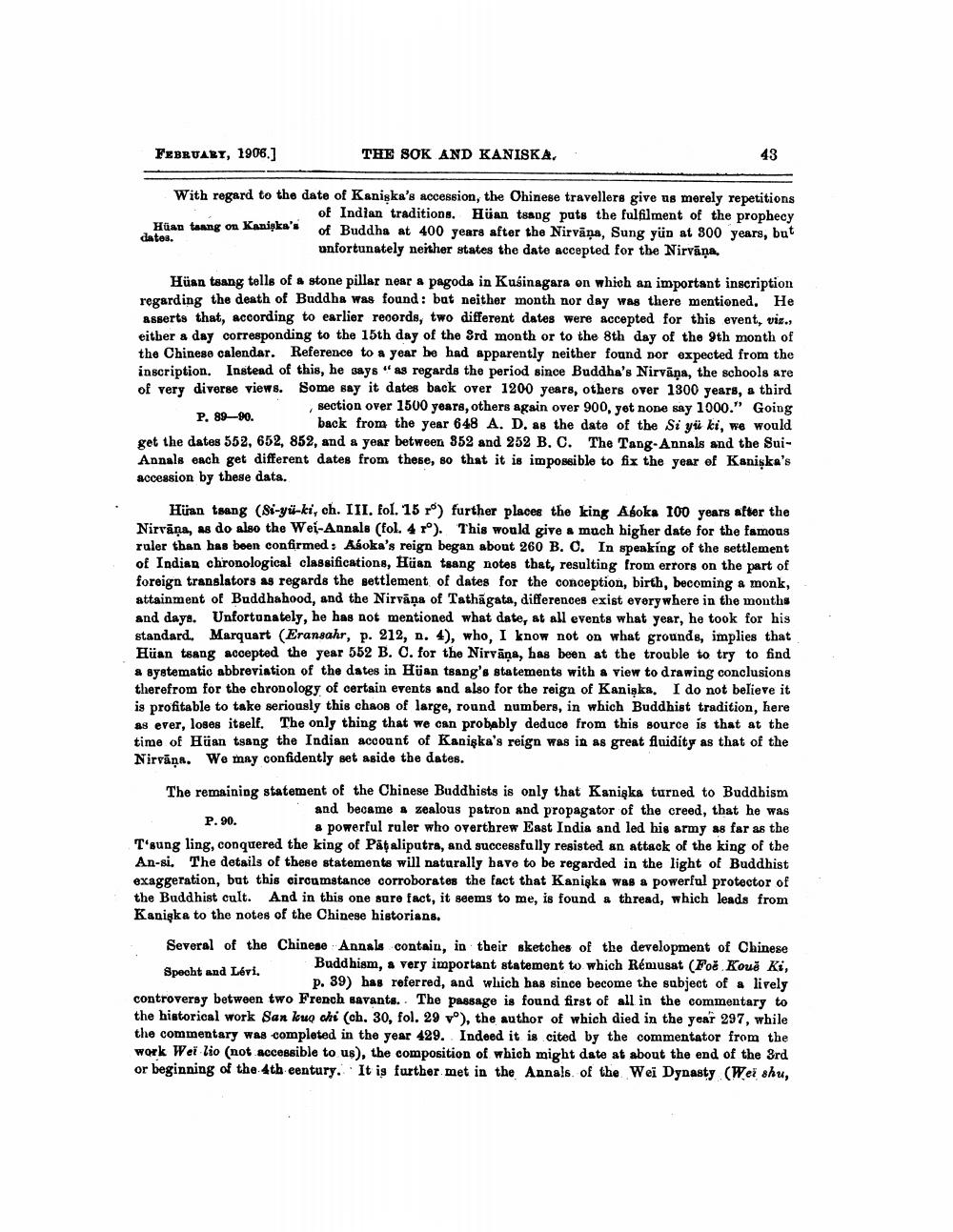________________
FEBRUARY, 1906.]
With regard to the date of Kaniska's accession, the Chinese travellers give us merely repetitions of Indian traditions. Hüan tsang puts the fulfilment of the prophecy of Buddha at 400 years after the Nirvana, Sung yün at 300 years, but unfortunately neither states the date accepted for the Nirvana.
Hüan taang on Kaniska's
dates.
THE SOK AND KANISKA,
43
Hüan teang tells of a stone pillar near a pagoda in Kusinagara on which an important inscription regarding the death of Buddha was found: but neither month nor day was there mentioned. He asserts that, according to earlier records, two different dates were accepted for this event, viz., either a day corresponding to the 15th day of the 3rd month or to the 8th day of the 9th month of the Chinese calendar. Reference to a year he had apparently neither found nor expected from the inscription. Instead of this, he says "as regards the period since Buddha's Nirvana, the schools are of very diverse views. Some say it dates back over 1200 years, others over 1300 years, a third section over 1500 years, others again over 900, yet none say 1000." Going back from the year 648 A. D. as the date of the Si yü ki, we would get the dates 552, 652, 852, and a year between 352 and 252 B. C. The Tang-Annals and the SuiAnnals each get different dates from these, so that it is impossible to fix the year of Kaniska's accession by these data.
/
P. 89-90.
Hüan tsang (Si-yü-ki, ch. III. fol. 15 r°) further places the king Aśoka 100 years after the Nirvana, as do also the Wei-Annals (fol. 4 r°). This would give a much higher date for the famous ruler than has been confirmed: Asoka's reign began about 260 B. C. In speaking of the settlement of Indian chronological classifications, Hüan tsang notes that, resulting from errors on the part of foreign translators as regards the settlement of dates for the conception, birth, becoming a monk, attainment of Buddhahood, and the Nirvana of Tathagata, differences exist everywhere in the months and days. Unfortunately, he has not mentioned what date, at all events what year, he took for his standard. Marquart (Eransahr, p. 212, n. 4), who, I know not on what grounds, implies that Hüan tsang accepted the year 552 B. C. for the Nirvana, has been at the trouble to try to find a systematic abbreviation of the dates in Hüan tsang's statements with a view to drawing conclusions therefrom for the chronology of certain events and also for the reign of Kaniska. I do not believe it is profitable to take seriously this chaos of large, round numbers, in which Buddhist tradition, here as ever, loses itself. The only thing that we can probably deduce from this source is that at the time of Hüan tsang the Indian account of Kaniska's reign was in as great fluidity as that of the Nirvana. We may confidently set aside the dates.
P. 90.
The remaining statement of the Chinese Buddhists is only that Kanişka turned to Buddhism and became a zealous patron and propagator of the creed, that he was a powerful ruler who overthrew East India and led his army as far as the T'sung ling, conquered the king of Pataliputra, and successfully resisted an attack of the king of the An-si. The details of these statements will naturally have to be regarded in the light of Buddhist exaggeration, but this circumstance corroborates the fact that Kaniska was a powerful protector of the Buddhist cult. And in this one sure fact, it seems to me, is found a thread, which leads from Kaniska to the notes of the Chinese historians.
Several of the
Specht and Lévi.
Chinese Annals contain, in their sketches of the development of Chinese Buddhism, a very important statement to which Rémusat (Foě Kouě Ki, p. 39) has referred, and which has since become the subject of a lively controversy between two French savants. The passage is found first of all in the commentary to the historical work San kuo chi (ch. 30, fol. 29 v°), the author of which died in the year 297, while the commentary was completed in the year 429. Indeed it is cited by the commentator from the work Wei lio (not accessible to us), the composition of which might date at about the end of the 3rd or beginning of the 4th century. It is further met in the Annals of the Wei Dynasty (Wei shu,




